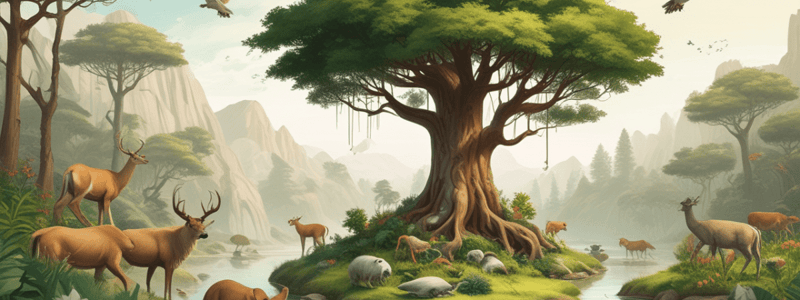Podcast
Questions and Answers
What does extinction mean in the context of species?
What does extinction mean in the context of species?
- A species is evolving into a new form
- A species is thriving in its environment
- A species no longer exists on Earth (correct)
- A species is migrating to a new habitat
What is the biggest threat to species extinction?
What is the biggest threat to species extinction?
- Natural disasters
- Disease and climate change
- Radiation and sea level changes
- Human activities and involvement (correct)
What is an example of a natural cause of extinction?
What is an example of a natural cause of extinction?
- Disease (correct)
- Hunting or poaching
- Introduction of invasive species
- Habitat loss from human expansion
What is the term for the event that led to the extinction of dinosaurs?
What is the term for the event that led to the extinction of dinosaurs?
What is a human activity that contributes to extinction?
What is a human activity that contributes to extinction?
What is the estimated rate of extinction due to human causes and other unnatural events compared to the natural extinction rate?
What is the estimated rate of extinction due to human causes and other unnatural events compared to the natural extinction rate?
What percentage of the Earth's land has been adapted for human use?
What percentage of the Earth's land has been adapted for human use?
What is the estimated percentage of species that would be affected by global warming if the Earth's temperature increases by 2 degrees Celsius?
What is the estimated percentage of species that would be affected by global warming if the Earth's temperature increases by 2 degrees Celsius?
What percentage of the Earth's freshwater resources have been used?
What percentage of the Earth's freshwater resources have been used?
What is the estimated number of species that go extinct each year in recent years?
What is the estimated number of species that go extinct each year in recent years?
What is the primary difference between mass extinction and background extinction?
What is the primary difference between mass extinction and background extinction?
What is the estimated percentage of species that die out in a mass extinction event?
What is the estimated percentage of species that die out in a mass extinction event?
What is the purpose of studying fossils in the context of extinction?
What is the purpose of studying fossils in the context of extinction?
What is a major factor in the natural extinction rate?
What is a major factor in the natural extinction rate?
What type of extinction has occurred five times in Earth's history?
What type of extinction has occurred five times in Earth's history?
Flashcards are hidden until you start studying
Study Notes
Extinction Definition
- Extinction means that something no longer exists, applying to species of plants, animals, and even humans.
- Extinction can be caused by natural or artificial processes that occur on Earth.
- Dinosaurs are a popular example of extinction, becoming extinct after the Cretaceous extinction over 65 million years ago.
Types of Extinction
- There are two main types of extinction: mass extinction and background extinction.
- Mass extinction is a rare phenomenon that occurs when a major catastrophe happens, resulting in a sudden and sweeping event that kills a large number of species.
- Background extinction is a natural process that occurs over a long period of time, resulting in the gradual decline and elimination of species from the Earth.
Mass Extinction
- Mass extinction is an extremely rare phenomenon that has only occurred five times on Earth.
- The five mass extinctions on Earth include: Ordovician-Silurian, Devonian, Permian ("The Great Dying"), Triassic, and Cretaceous.
- Fossils are essential in learning about the mass extinctions of the past, allowing scientists to estimate the date range of the event and how the lives of the species still in existence were affected.
Background Extinction
- Background extinction, also called the normal extinction rate, is the natural evolution and elimination of species from the Earth over a long period of time.
- The natural extinction rate is one species out of every one million species per year based on fossil records.
- Factors contributing to background extinction include climate change and population control.
Human Activity and Extinction
- Human practices such as manufacturing, lumbering, and fishing all have a consequence within the ecosystems of Earth.
- Pollution, habitat loss, and overhunting are major reasons that species increasingly face extinction.
- Human activity has not always been linked to extinction, but in recent years, it has become a subject of discussion.
- Deforestation, using more land, and dumping trash into landfills are major contributors to extinction.
Statistics on Human Impact
- 75% of land has been adapted for human use, taking away habitat for other species.
- 33% of the land on Earth is used for farming and agriculture, taking away large amounts of habitat for indigenous species.
- 66% of oceans have been used for human development.
- 75% of Earth's freshwater resources have been used.
- 25% of pollution comes from greenhouse gas emissions.
- Fertilizers used in farming are a large contributor to pollution.
- Global warming and rising sea levels can partially be attributed to pollution.
- 5% of species would be affected by global warming if the Earth was heated just 2 degrees Celsius.
- 16% of species face the threat of extinction with the current global warming trajectory.
Studying That Suits You
Use AI to generate personalized quizzes and flashcards to suit your learning preferences.



